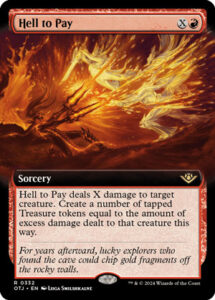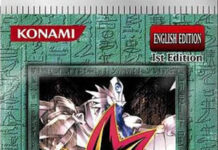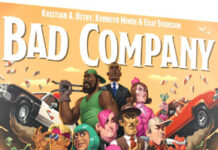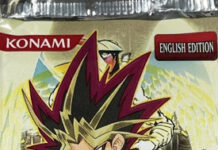Wizards of the Coast would never admit it, but I suspect that one of the things that convinced them to eventually do a Wild West set was a fan-made set named Lorado. It was created by a player who went by Shadowcentaur, and much like Outlaws of Thunder Junction, it has a lot of the simple things you would expect from a Western or frontier-themed set. There are lots of people in cowboy hats, a kindred deck based on cattle herds, and a minor mechanic inspired by poker. But Lorado actually has more than that. It is most properly described as a Weird West setting, which means it has elements of eldritch fantasy and cards depicting ancient mysteries that even the locals don’t understand. And it has a specific focus on American mythology – Shadowcentaur themselves drew attention to this in the original write-up and considered it a major theme. There are cards that depict Midwestern cryptids, references to Native American folktales and mythology, and a marquee planeswalker inspired by Dorothy Gale (ie. The Wizard of Oz).
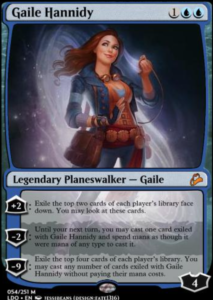
I’ve lived the majority of my life in Australia, but I was born in the United States and spent many of my formative years there – America’s mythic stories still move me the way they always have. And I say that American mythology is tragically under-recognized in fantasy products like Magic. This is partly because even a lot of Americans don’t think about their stories in that way. Mythology is seen as something old and distant, and the United States has existed for only two hundred and fifty years and is is seen as a hyper-modern society. The fact is, though, that every place has its own mythology, whether it’s an “old country” or a “new” one. Telling stories in an attempt to understand the strange world around you, to make sense of your life’s experiences, and to preserve the knowledge and wisdom that matters most is a human impulse, and it is not limited to any one side of any particular ocean. Every culture has a mythic soul, whether it realizes it or not.
There are tantalizing hints of a mythic soul in Outlaws of Thunder Junction. The Fomori vault that the characters were seeking, the subject of the Big Score bonus cards, is clearly a reference to the mysterious Anasazi people of the Southwest. While some people criticized the story of the uninhabited plane, its awakening magic, and the birth of the cactusfolk for its apparent similarities to the historical “Terra Nullius” doctrine, when considered on its own it feels much like a creation myth suitable for any world. Yet these are explored very little, entirely too little considering the storytelling potential. At the very least, it could have made for some interesting flavor text, but yet again, there is not as much of that as you would expect. The references that do exist are setting up the role of the Fomori in stories to come; with so little, I already fear that the upcoming plot may be as rushed and cramped as March of the Machine.
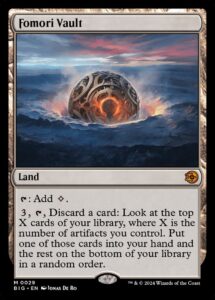
I understand the need for design innovation and I welcome it. But the choices made for many recent design innovations add up to a hockey-stick graph of comprehension complexity, and this is concerning both from a game design perspective and from a flavor perspective. The former seems to be driving burnout among some players, not to mention the proliferation of anti-wordiness cubes; the latter is being constrained by the fact that too many cards only have game text, making it hard to find a hook for interest in the world.
I’ve seen some disturbingly aggressive comments from people about how it doesn’t matter if the game doesn’t have much flavor text. Some of this may come from a place of legitimate interest in different elements of the game, such as understanding mechanical design, optimizing decklists, or the like, and thus be merely mis-expressed rather than malicious. But other people have a legitimate interest in things like flavor text, and in the background and worldbuilding from which the flavor text derives. There should be room for all of these interests in Magic. There used to be more room for all of these interests in Magic. In recent sets, the pendulum has swung too far in the direction of comprehension complexity. People have done math, and found that if you’re not yet familiar with a set, you have to read a novella’s worth of game text when you draft it. You have to read at least as much to build a casual deck, or decide how new cards fit with your favorite Commander. That’s not fun to everyone. Not everyone has that much time. And some of the sets which need flavor the most, like Outlaws of Thunder Junction, do not get near enough.
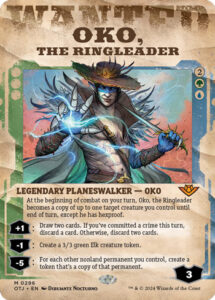
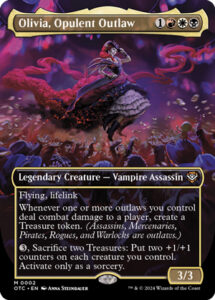
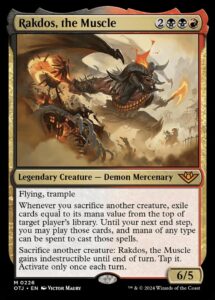
The set is full of famous legendary creatures, to the point of almost being like a Dominaria set; but unlike a Dominaria set, it’s not clear how and why they’re here. Many of them are villainous or chaotic characters looking for a place to get rich quick or just have fun, which is certainly a fitting concept for a Wild West set. But did everyone in the Multiverse learn about Omenpaths instantly? Did they all know how to navigate them, much less to a specific location they want? That’s the kind of thing that might take twenty years to figure out; it’s not out of the question that magic would help, but it takes readers out of the setting when they realize that navigating the Omenpaths, creating settlements, setting up chartered companies, building magi-tech power lines and train tracks, famous characters from across the multiverse arriving, and Oko’s heist going ahead, all happened within months of March of the Machine.
And the sad thing is, avoiding this wouldn’t even have required them to confront their unwillingness to let time pass, and to write an artist’s guide to drawing Chandra at the age of 43. We’ve talked in some previous gameplay-free reviews about how they claim to reserve the right to have multiple consecutive sets on a plane when necessary. Thunder Junction is another example of a story that would have fit well in a dyad of sets, and they could have made the hypothetical Awakening of Thunder Junction take place twenty years ago. Maybe back then it was a relatively unknown plane in a distant part of the multiverse, where a select few planeswalkers set up rudimentary facilities. They almost seemed to know this when the web stories mentioned Jace having been sent there briefly on a previously-unknown Infinite Consortium mission, but it was only to set up something to do with the Vault, and clearly not part of anything beyond that. Maybe it would have given us a chance to see planeswalkers who don’t have much of a role in the current canon, and deepen some of their backstories – Tezzeret in a different stage of his servitude to Bolas, Garruk on the hunt for obscure prey, and Mu Yanling as a nod to the influence of Asian immigrants on America’s frontier come to my mind. Maybe the Omenpaths would have led to the same shockingly abrupt flood of settlers, but at least they would have had something to build on and been part of a deeper story.
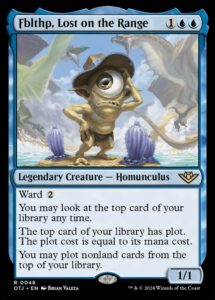
In our timeline, of course, none of that happened, and digging into some of the comments and discussion is a little disheartening. Apparently Wizards of the Coast originally concepted Outlaws of Thunder Junction as a villain-themed set, in the vein of M19’s focus on Nicol Bolas, and applied the Wild West aesthetics later on. They themselves may have given up their game in the card Fblthp, Lost on the Range – the character is a literal meme, and it’s almost surprising that the card has real game text. It seems a lot like the set doesn’t have an endgame beyond drawing lots of legendary creatures in ten-gallon hats. If that’s the set’s goal, it hits it fine – pick up any random Thunder Junction card, and your reaction will most likely be “yeah, that looks pretty cool!”. Try to dive deeper, and you hit bottom right away. The web stories are decently readable, but you don’t get much insight from them. Kellan’s long-awaited face-to-face with Oko is underwhelming and its outcome is entirely predictable, and they obviously thought Jace’s return and mysterious dialogue would be much more intriguing and impactful than they are. The Wild West tropes portrayed on the cards are very easy and mostly played straight. Casting a spell named “This Town Ain’t Big Enough” will make almost anyone smile, but beyond those moments, it’s not clear why it’s significant that this is a Magic set and a Magic plane (linked again to the problem of too little flavor text and at least one too few sets).
I doubt that they actually put much less effort into Outlaws of Thunder Junction than other sets – but it’s easy to feel like they did. It’s tempting to conclude that a Wild West set is “easy” to do, and thus save time in this era of incredibly hectic release schedules. To be clear, I do not believe a Wild West setting is easy – it involves America’s mythic soul, and requires the same kind of care that an expansion like Theros or Champions of Kamigawa involved. Wizards of the Coast may have felt they were taking care, but the set’s non-gameplay elements are hard to defend on any deeper level. I am tired of this situation. My gameplay-free review series was intended to talk about flavor, lore, and art, but for both Thunder Junction and Murders at Karlov Manor, I have ended up talking more about how the set was made, and I don’t like it.
The American frontier is associated with the phrase “Go West, young man”, referring to seeking fortune and personal growth. We sometimes forget that there is an older usage of the term, in which to go west means to die (likely referencing the Celtic Otherworld). I do not think Magic is dying, in the sense that it will soon cease publication. I do think that we are going to keep getting sets with bizarre choices and mistakes, with some degree of disappointing elements and decisions. Wizards of the Coast has been staying its course to date because people like their products and the art, and combined with Commander’s ravenous desire for new legends and deck tweaks, they make a profit. But as the stories of the Old West tell us, these things catch up with you. Whether it’s through the roar of cannons and clouds of smoke on a blood-soaked battlefield, or in a personal final duel on a one-horse town’s dusty main street, at some point you will have to face the consequences. I hope that when that time comes, they are able to bend, not break, because we all need something to change.
